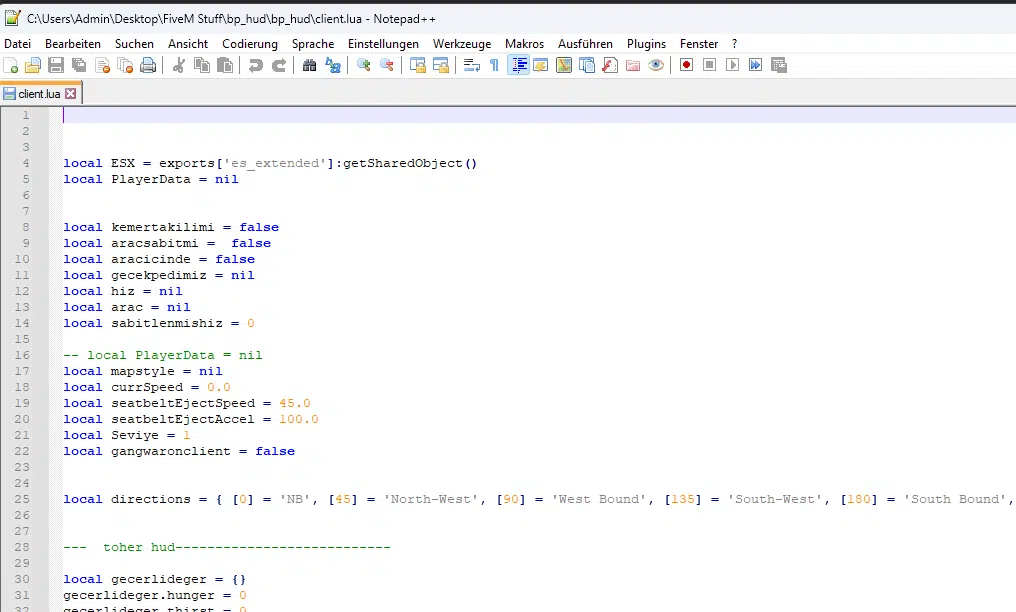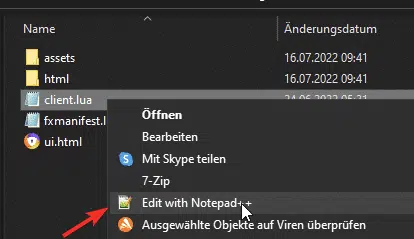If you’re running a FiveM server in another language—whether it’s German, French, Spanish, or anything else—you’re probably looking to make your scripts accessible to your community. Today, we’re going to dive into how you can translate those FiveM scripts.
First Step: Download Notepad++ (Editor)
Forget Notepad. Forget basic text editors. We’re talking Notepad++—a powerhouse for editing code. It’s color-coded, it’s sleek, and it’s built for efficiency. If you’re going to be translating scripts, this is the only tool you need. You can grab it here: Notepad++ Download.
You can download the program via this link: https://notepad-plus-plus.org/downloads/
Trust me, this will make your life a whole lot easier.

Step 2: Open the Script You Want to Translate
Once you’ve got Notepad++ ready, it’s time to grab your script. Download the LUA file from the developer’s server—right-click on the link and hit “Save Link As.” Afterward, drag that file into Notepad++ to start translating.
Then, open the script with notepad++ by right clicking:

To start translating, simply review each line of code as follows:

Step 3: Start Translating (But Stay Focused)
Now, here’s the key: Don’t touch the code variables. All you need to focus on are the text strings—the ones wrapped in quotes like "Hello World". These are the pieces you’ll be translating.
Go through the server.lua and client.lua files, identify the strings, and translate them carefully. Don’t overthink it—just make sure the translations fit the context. Once you’re done, run some tests to make sure you didn’t miss anything.
Step 4: Save Your Translations
When you’re done, hit that save button at the top left. Then, if you’ve translated a script that could help others, upload it to the developer’s GitHub via a Pull Request. The developer will review it, test it, and if all goes well, merge it. Don’t expect immediate responses—sometimes developers need time to process things.
Pro Tip: Ask for Help
Translating scripts isn’t a walk in the park. If you’re stuck, ask your team. No one’s got all the answers, but working together makes the job easier and faster. Pooling your knowledge is how you get things done right.
Step 5: Be Cautious
Alright, now let’s talk about what NOT to do when translating. Here’s a quick list of things you need to be careful about:
- Only Translate Strings. Don’t touch any variables or code logic. Only the stuff inside quotes, like
"Hello"->"Hallo".Example:
Correct:print("Hello World")->print("Hallo Welt")
Wrong:variableName = "Hello World"(Don’t mess with the variable name.) - Preserve Formatting. If you see
%s,%d, or any placeholders in your string, leave them alone. These are there for a reason and must stay intact.
Example:print("Welcome, %s!")->print("Willkommen, %s!") - File Encoding is Key. Always save your files in UTF-8. That’s how you avoid issues with special characters like
ä,ö, orü. - Consistency is King. If you’re translating a term like “Police”, it needs to stay the same throughout. Don’t switch between “Polizei” and “Wache” for the same thing.
- Don’t Delete Comments. Comments are there for a reason—they guide the code. You don’t have to read them, but don’t remove them either.
- Test After Translating. Throw your script onto a test server and look for errors. Check for console issues (press F8), missing translations, and make sure the logic still holds up.
- Backup First. Always make a backup of the script before you touch it. Better safe than sorry.
Quick Summary:
- Translate only text inside quotes.
- Leave code logic and variables alone.
- Keep formatting and placeholders intact.
- Test your translations.
- Backup your script before editing.
Need More Help?
If you’re tired of doing this manually, we’ve got something that’ll make your life easier. Check out our AI-powered Script Translator at fivemx.com/ai. With this tool, you can quickly translate LUA scripts with accuracy, saving you time and headaches.
Wrap-Up
That’s the rundown. If you follow these steps, translating scripts won’t be a nightmare. Just take it slow, be meticulous, and collaborate with your team.
Got any questions? Drop them in the comments. Let’s get translating, folks
Also: You can also use AI (like ChatGPT)
Click here for our AI tool
Hopefully, this guide has been enough to get you started on your journey of translating scripts.
Questions? Leave a comment down below.
